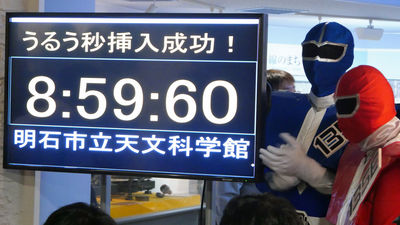'Negative leap seconds' may be created by the faster rotation of the earth

The time division of '1 day' is roughly determined by the rotation of the earth, but in reality, the length of time is strictly defined based on the state of the atom
Shorter Days as Earth's Rotation Speeds Up
https://www.timeanddate.com/time/earth-faster-rotation.html
Earth is whipping around quicker than it has in a half-century | Live Science
https://www.livescience.com/earth-spinning-faster-negative-leap-second.html
Since it was once thought that the rotation period of the earth was constant, the length of time of 1 second was defined as '1/86400 of the rotation period of the earth', but the rotation speed of the earth is the ocean current. It turns out that it is not constant due to the influence of the air circulation. Therefore, the International Committee for Weights and Measures in 1956 redefined the length of one second as ' 1/31,556,925,747, one cycle of the earth's revolution measured from 12:00 on December 31, 1899. '
However, this definition also had a problem with reproducibility because past reference values could not be remeasured. Therefore, the International Committee for Weights and Measures in 1967 defined 1 second as ' the length when the ground state hyperfine structure transition frequency that is not perturbed by cesium-133 atoms is defined as 9,192,631,770 Hz. ' ..
Cesium-133 has two energy states, 'ground state' and 'excited state', and it changes from the ground state to the excited state by applying a specific microwave. The time it takes for this particular microwave to vibrate 9,192,631,770 times is defined as one second. By using the cesium-133 atom, modern humans have a highly reproducible definition of time.

However, there will be a slight discrepancy between the atomic time defined by the definition of seconds defined by the nature of the atom and the astronomical time defined by the movement of the earth. Therefore, the gap between atomic time and astronomical time is corrected by adding 'leap second' from time to time. The leap second is inserted for 1 second on January 1st or July 1st in the form of 23:59:59 → 23:59:60 → 00:00:00, 27 times in total at the time of article creation. It has been added.
You can see the moment when the leap second is actually inserted in the following article.

However, it is reported that 2020 was the shortest year in the observation record. Since 1973, the shortest rotation cycle of the earth was on July 5, 2005, which was 86,400 seconds to 1.0516 milliseconds, but one day was shorter than that record in 2020. It was observed 28 times. The shortest day was July 19, 2020, which was 86,400 seconds to 1.4602 seconds. From this, it is possible that the rotation of the earth is faster than before.
Since the introduction of the leap second system in 1972, the earth's rotation period has averaged slightly longer than 86,400 seconds, so the leap second has been a positive number of '+1 second'. However, as the Earth rotates faster, it is expected that a negative leap second of '-1 second' will be required. This means that 23:59:58 → 0:00:00 and 23:59:59 will be skipped on the clock.

However, Peter Witzbury, a physicist at the British National Institute of Physics, said, 'If the Earth's rotation cycle is even faster, negative leap seconds may be needed, but is it really needed? I think it's too early to decide. ' Scientists from the International Telecommunication Union have said that 'the introduction of leap seconds should be temporarily stopped rather than the introduction of negative leap seconds.'
The International Earth Rotation and Reference Systems project, which decides to introduce leap seconds, has not announced plans to add new leap seconds at the time of writing the article.
Related Posts:
in Science, Posted by log1i_yk






